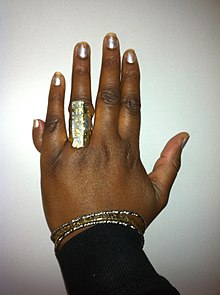
Back كثرة الأصابع Arabic Полидактилия Bulgarian Polidaktilija BS Polidactília Catalan فرەقامکی CKB Polydaktylie Czech Polydactyli Danish Polydaktylie German Polidaktilio Esperanto Polidactilia Spanish
| Polydactyly | |
|---|---|
| Other names | Hyperdactyly;[1] polydactylism; supernumerary digits |
 | |
| A left hand with postaxial extra finger | |
| Specialty | Medical genetics |
| Symptoms | Extra fingers or toes[2] |
| Complications | Pain, low self-esteem, clumsiness[3] |
| Usual onset | Early development[1] |
| Types | Syndromic Non-syndromic: Pre-axial, axial or central, postaxial[1] |
| Treatment | Surgery[3] |
| Frequency | 4 to 12 per 10,000[1] |
Polydactyly is a birth defect that results in extra fingers or toes.[2] The hands are more commonly involved than the feet.[2] Extra fingers may be painful, affect self-esteem, or result in clumsiness.[3]
It is associated with at least 39 genetic mutations.[4] It may either present alone or with other defects.[2] Cases may run in families.[2] The underlying mechanism involves an error in limb bud formation during early development.[1] Diagnosis may occur before birth via prenatal ultrasound as early as nine weeks.[2] Xrays may be useful after a child is a year old.[3] The opposite is oligodactyly (fewer fingers or toes).
Treatment varies from removal by cautery to more involved surgery.[3] While putting a tight band around the base has been carried out, this is not typically recommended.[3] If surgery is required, this is often done around two years of age.[3] Occasionally multiple surgeries are required.[3]
Polydactyly is present in about 4 to 12 per 10,000 newborns.[1] It is the most common defect of the hands and feet.[2] In the United States, Black people are more commonly affected than white people.[2] The term is from from Greek πολύς (polys) 'many' and δάκτυλος (daktylos) 'finger'.[5]
- ^ a b c d e f Bubshait, DK (16 December 2022). "A review of polydactyly and its inheritance: Connecting the dots". Medicine. 101 (50): e32060. doi:10.1097/MD.0000000000032060. PMC 9771235. PMID 36550802.
- ^ a b c d e f g h Al Amin, ASM; Carter, KR (January 2024). "Polydactyly". StatPearls. PMID 32965966. Retrieved 17 December 2024.
- ^ a b c d e f g h "Polydactyly (Extra Fingers or Toes) and Corrective Surgery | HSS". Hospital for Special Surgery. Retrieved 17 December 2024.
- ^ Biesecker LG (2002). "Polydactyly: how many disorders and how many genes". Am J Med Genet. 12 (3): 279–83. doi:10.1002/ajmg.10779. PMID 12357471.
- ^ "Polydactyly Etymology". Online Etymology Dictionary. Archived from the original on October 9, 2016. Retrieved February 13, 2016.